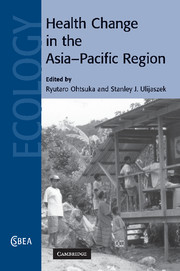Book contents
- Frontmatter
- Contents
- List of contributors
- Acknowledgements
- 1 Health change in the Asia-Pacific region: disparate end-points?
- 2 Interactions of nutrition, genetics and infectious disease in the Pacific: implications for prehistoric migrations
- 3 Biocultural adaptation and population connectedness in the Asia-Pacific region
- 4 Changing nutritional health in South East Asia
- 5 Obesity and nutritional health in Hong Kong Chinese people
- 6 Modernization, nutritional adaptability and health in Papua New Guinea Highlanders and Solomon Islanders
- 7 Tongan obesity: causes and consequences
- 8 Nutrition and health in modernizing Samoans: temporal trends and adaptive perspectives
- 9 Health patterns of Pacific Islanders and Asians in the United States
- 10 Impacts of modernization and transnationalism on nutritional health of Cook Islanders
- 11 Mortality decline in the Pacific: economic development and other explanations
- 12 Health changes in Papua New Guinea: from adaptation to double jeopardy?
- Index
- References
7 - Tongan obesity: causes and consequences
Published online by Cambridge University Press: 15 September 2009
- Frontmatter
- Contents
- List of contributors
- Acknowledgements
- 1 Health change in the Asia-Pacific region: disparate end-points?
- 2 Interactions of nutrition, genetics and infectious disease in the Pacific: implications for prehistoric migrations
- 3 Biocultural adaptation and population connectedness in the Asia-Pacific region
- 4 Changing nutritional health in South East Asia
- 5 Obesity and nutritional health in Hong Kong Chinese people
- 6 Modernization, nutritional adaptability and health in Papua New Guinea Highlanders and Solomon Islanders
- 7 Tongan obesity: causes and consequences
- 8 Nutrition and health in modernizing Samoans: temporal trends and adaptive perspectives
- 9 Health patterns of Pacific Islanders and Asians in the United States
- 10 Impacts of modernization and transnationalism on nutritional health of Cook Islanders
- 11 Mortality decline in the Pacific: economic development and other explanations
- 12 Health changes in Papua New Guinea: from adaptation to double jeopardy?
- Index
- References
Summary
Introduction
The World Health Organization (WHO 2000) warns that obesity has become a global endemic since it has increased over the past several decades in both developed and developing countries. One of the regions showing the highest prevalences is Polynesia, where much obesity-related nutritional and health research has been carried out (Inaoka 2002; Inaoka et al. 2003). The frequency of obesity, as judged by body mass index (BMI) (body weight (kg)/body height (m)2), is higher in Polynesians than in other Pacific Islanders; in urban rather than rural dwellers, and in females rather than males (Hodge et al. 1995a, b). In addition, Polynesian migrants in the United States (Hawaii and California, in particular), New Zealand and Australia are characterized by high obesity rates, causing serious health and social problems in those countries (Kumanyika 1993; McAnulty and Scragg 1996; Simmons 1996). Prevalence of obesity among Polynesians has been increasing (Ulijaszek 2000, 2001), in association with elevated incidence of degenerative diseases such as non-insulin-dependent diabetes mellitus (NIDDM) (Hodge et al. 1995a, 1996; Bell et al. 2001; Colagiuri et al. 2002), although their mortalities have been considerably masked due to the availability of reasonably advanced health care systems in such countries. As elsewhere in the world, obesity among Polynesians is due to combined effects of genetics and environment (Fig. 7.1). Since Neel (1962, 1982) suggested the ‘thrifty genotype’ hypothesis, many obesity-related genes have been reported (Joffe and Zimmet 1998; Chukwuma and Tuomilehto 1998; de Silva et al. 1999; Kagawa et al. 2002).
- Type
- Chapter
- Information
- Health Change in the Asia-Pacific Region , pp. 127 - 146Publisher: Cambridge University PressPrint publication year: 2007
References
- 3
- Cited by

